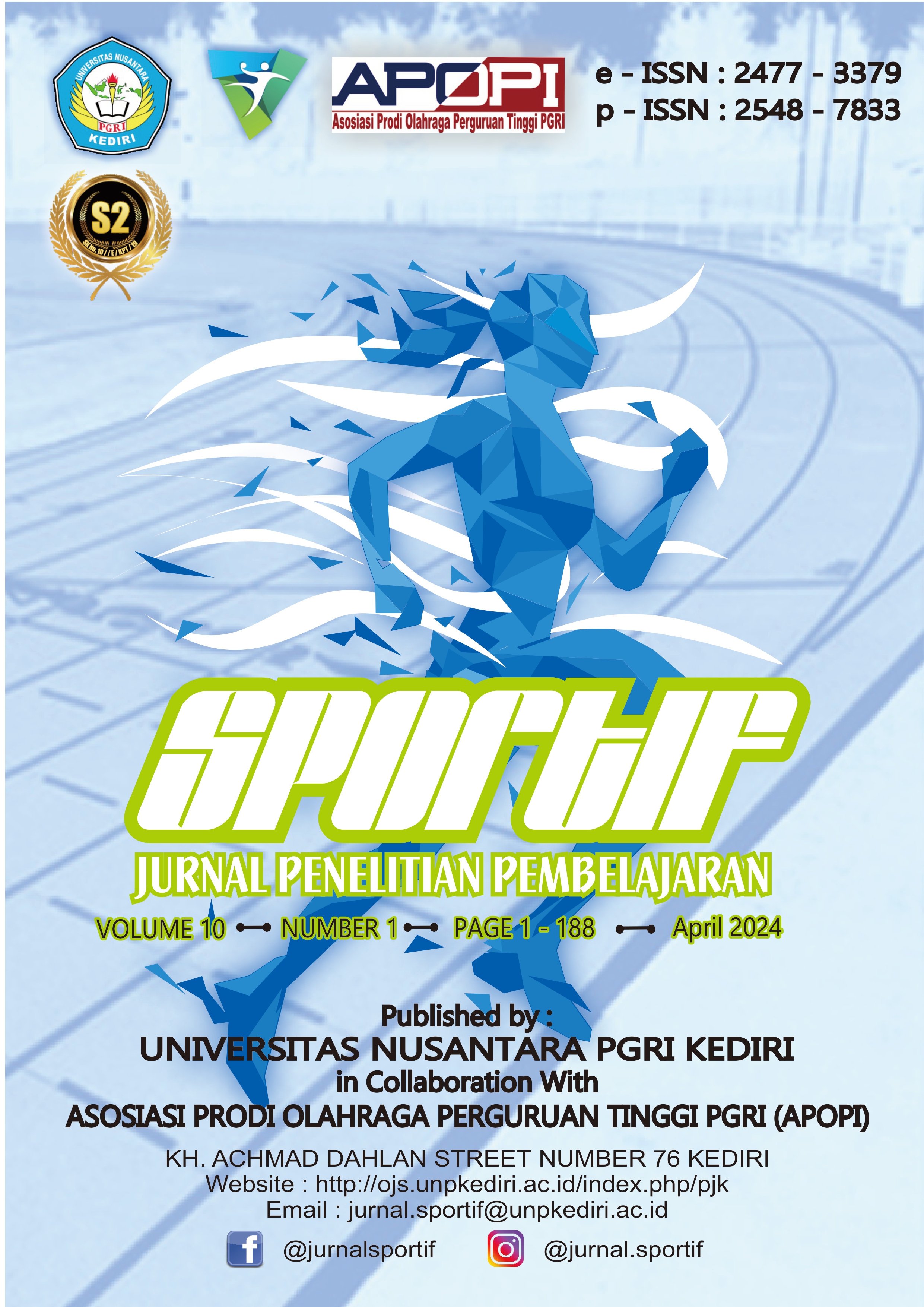Abstrak
Ketidakakuratan smash atlet sepak takraw dipengaruhi oleh beberapa faktor, seperti tinggi lompatan, fleksibilitas, dan kepercayaan diri. Tujuan dari penelitian ini adalah untuk mengungkap dan membuktikan pengaruh langsung, tidak langsung, dan simultan dari tinggi lompatan, kelenturan, dan kepercayaan diri terhadap akurasi smash atlet sepak takraw. Jenis penelitian ini adalah kuantitatif dan asosiatif dengan pendekatan melalui analisis jalur (Path Analysis). Sebanyak 20 sampel atlet sepak takraw PSTI Muaro Bungo adalah PSTI (persatuan sepak takraw seluruh indonesia) usia (20 tahun) jenis kelamin (10 wanita, 10 pria). Instrumen lompat tinggi menggunakan Vertical Jump, fleksibilitas menggunakan Flexiometer, kepercayaan diri menggunakan kuesioner, dan uji akurasi Smash sepak takraw. Data dianalisis menggunakan analisis jalur dengan pengujian model struktur pada α = 0,05. Hasil temuan menunjukkan bahwa tinggi lompat (26,52%), fleksibilitas (5,06%), dan kepercayaan diri (25,5%) memiliki efek positif langsung terhadap akurasi smash sepak takraw. Selain itu, ketinggian lompatan secara tidak langsung memengaruhi akurasi melalui kepercayaan diri (40,44%), sedangkan fleksibilitas secara tidak langsung memengaruhi akurasi melalui kepercayaan diri (1,06%). Secara bersamaan, tinggi lompatan, fleksibilitas, dan kepercayaan diri secara kolektif menjelaskan 89,7% varians dalam akurasi smash. Singkatnya, penelitian ini mengungkapkan bahwa ketinggian lompatan yang lebih tinggi, fleksibilitas yang lebih besar, dan peningkatan kepercayaan diri secara signifikan berkontribusi pada peningkatan akurasi smash sepak takraw, selaras dengan tujuan penelitian. Berdasarkan hasil di atas, kesimpulannya adalah terdapat pengaruh lompat, fleksibilitas, dan kepercayaan diri yang tinggi terhadap akurasi smash atlet sepak takraw PSTI Muaro Bungo.
Referensi
Abdul Mubin, A., & Ahmad, N. (2015). Aerodynamic Study of a Modern Sepak Takraw Ball Using Smoke Flow Visualization Technique. Malaysian Journal of Movement, Health & Exercise, 4(2), 19. https://doi.org/10.4103/2600-9404.323226
Abdullah, K. H. (2022). A Bibliometric and Scoping Retrospective of Sepak Takraw. Asian Journal of Arts, Culture and Tourism, 4(4), 23–37.
Aji, T., & Yudhistira, D. (2023). The Effect of Hanging Ball Training Method to Improve Kedeng Smash Skill of Sepak Takraw Athletes in Panca Event Games. Unima International Conference on Social Sciences and Humanities (UNICSSH 2022), 1023–1029. https://doi.org/10.2991/978-2-494069-35-0_123
Akmal Roszani, M. A., Zainuddin, N. F., Mohd Aznan, E. A., Jamaludin, M., Ismail, Z., & Miswan, M. S. (2023). Analysis of Spiking Technique towards Point Distribution Succession in Sepak Takraw League (STL) Champions Cup 2021. Journal of Human Centered Technology, 2(1), 68–72. https://doi.org/10.11113/humentech.v2n1.43
Ardiansyah, R. T., & Bulqini, A. (2020). Hubungan Koordinasi Mata Kaki Dan Fleksibilitas Sendi Panggul Terhadap Hasil Akurasi Servis Pada Tekong Atlet Sepak Takraw Smanor Jawa Timur. JSES : Journal of Sport and Exercise Science, 3(1), 01. https://doi.org/10.26740/jses.v3n1.p01-08
Arifin, W. N., & Rosly, S. (2015). The relationship between flexibility, power and speed in elite Malaysian soccer players. Journal of Physical Education and Sport, 15(4), 671–676. https://doi.org/10.7752/jpes.2015.04097
Chen, S., Dai, H., Tang, J., & Xiao, R. (2018). Physiological Profile of Sepak Takraw University Players. 4(4), 63–66. https://doi.org/10.26480/icecsd.01.2018.63.66
Febrianto, A., Sulaiman, S., & Hidayah, T. (2022). The Contribution of Leg Length, Leg Flexibility and Leg Speed to the Results of Kedeng Sepaktakraw’s Smash Ability. JUARA: Jurnal Olahraga, 7(2), 390–397. https://doi.org/10.33222/juara.v7i2.1970
Hakim, A., Zainur, Z., Adila, F., Ittaqwa, I., & Ramatullah, M. I. (2022). Kontribusi Power Otot Tungkai Dan Fleksibilitas Terhadap Keterampilan Smash Sepak Takraw Di Club Rangsang Kabupaten Pulau Meranti. Riyadhoh : Jurnal Pendidikan Olahraga, 5(2), 153. https://doi.org/10.31602/rjpo.v5i2.8965
Hidayatullah, M. A., Doewes, M., & Kunta Purnama, S. (2022). The effect of stretching exercises on flexibility for students. Jurnal SPORTIF : Jurnal Penelitian Pembelajaran, 8(1), 118–130. https://doi.org/10.29407/js_unpgri.v8i1.17742
Humairoh, Z., Yendrizal, Y., Arsil, A., Pranoto, N. W., & Zarya, F. (2023). The effect of leg muscle explosiveness, agility, and flexibility on the Padang Club Athletics 100 sprint. Jorpres (Jurnal Olahraga Prestasi), 19(1), 21–31. https://doi.org/10.21831/jorpres.v19i1.60701
Irawan, R., Padli, V. E., Purba, R. H., & Susanti, S. A. (2021). Developing of top serve accuracy test on Sepak takraw sport game. https://doi.org/10.14198/jhse.2021.16.Proc3.48
Jakiwa, J., Rustam, S., Atan, S. A., Azli, M. S., Maliki, A. B. H. M., Nadzmi, A., Rahman, A. F. A., Samsir, M. S., Sun, Z., Kuo, P. T., & Bee, N. C. T. S. (2023). The Effects of Multi-Sport Intervention on Agility Performance among Young Athletes. International Journal of Human Movement and Sports Sciences, 11(4), 864–871. https://doi.org/10.13189/saj.2023.110421
Kosni, N. A., Abdullah, M. R., Juahir, H., Maliki, A. B. H. M., & Musa, R. M. (2018). Establishing reliability of performance indicator of sepak takraw using notational analysis. Journal of Fundamental and Applied Sciences, 9(2S), 1. https://doi.org/10.4314/jfas.v9i2s.1
Purnomo, A., & Hariono, A. (2020). Self-confidence due to ability of Three Meter Smash in Volleyball. Jurnal SPORTIF : Jurnal Penelitian Pembelajaran, 6(2), 541-549. https://doi.org/10.29407/js_unpgri.v6i2.14616
Purwanto, D. (2022). Quality of the physical condition and basic techniques of sepak takraw. Jurnal SPORTIF : Jurnal Penelitian Pembelajaran, 8(2), 241–258. https://doi.org/10.29407/js_unpgri.v8i2.18447
Setiawan, F. R., Sugihartono, T., & Nopiyanto, Y. E. (2022). Kontribusi Daya Ledak Otot Tungkai Terhadap Kemampuan Smash Atlet Sepak Takraw Pada Ekstrakurikuler di Smp Negeri 12 Kota Bengkulu. Sport Gymnatics: Jurnal Ilmiah Pendidikan Jasmani, 3(2), 226–239. https://doi.org/10.33369/gymnastics
Silalertdetkul, S. (2016). Impact of sepak takraw practice on inflammatory markers in male athletes. Songklanakarin Journal of Science and Technology, 38(3), 289–294. https://doi.org/10.14456/sjst-psu.2016.39
Sukadana, I. G., & Suwardi, E. (2017). Pengaruh Tinggi Lompatan Terhadap Ketepatan Smash pada Atlet Sepak Takraw. Jurnal Ilmiah Pendidikan Jasmani (JIPJ, 3(2), 68–77. https://doi.org/10.23887/jipj.v3i2.11151
Sulaiman, M., Raharjo, A., & Abidin, W. Z. (2018). Effect of Plyometric Tuck Jumps and Lateral Hurdle Jumps on The Ability of Takraw’S Male Athletes to Do Smash Kedeng. International Seminar on Public Health and Education 2018 (ISPHE 2018), 124–127. https://doi.org/10.2991/isphe-18.2018.28
Udomtaku, K., & Konharn, K. (2020). Energy expenditure and movement activity analysis of sepaktakraw players in the Thailand league. Journal of Exercise Science and Fitness, 18(3), 136–141. https://doi.org/10.1016/j.jesf.2020.04.001
Utamayasa, I. (2023). Improving Player Performance in Five Event Sepaktakraw Through Physical Training. Journal of Advanced Zoology, 44(4), 125–128. https://doi.org/10.17762/jaz.v44i4.465
V. Jonathan, P., A. Hendely, A., & A. Stephen, F. (2021). Mental Strength among MSU Athletes in Sports Performance. International Journal of Science and Management Studies (IJSMS), December, 105–115. https://doi.org/10.51386/25815946/ijsms-v4i6p112
Wiyaka, I., Adikahriani, A., & Soewandi, S. (2021). Profil Kondisi Psikis Atlet Putra Sepak Takraw Sumut Pelatda Pon Xx. Jurnal Prestasi, 5(1), 38. https://doi.org/10.24114/jp.v5i1.25614
##submission.copyrightStatement##


